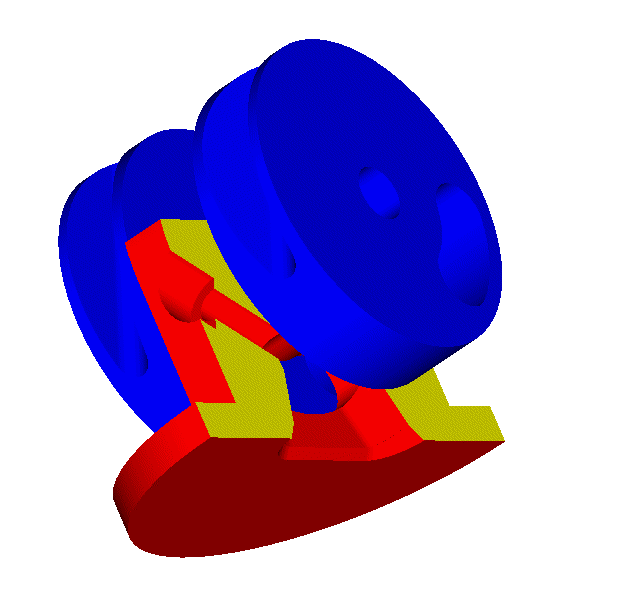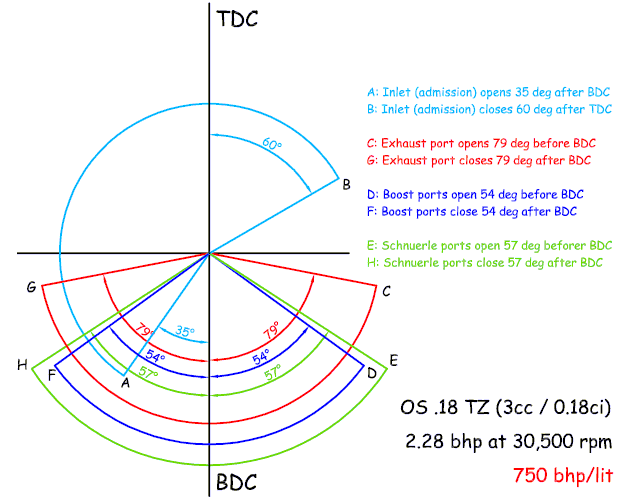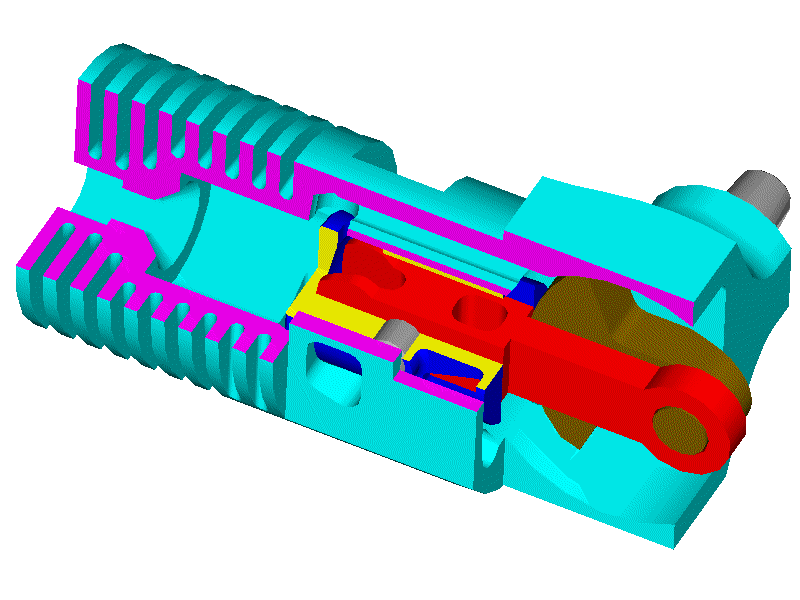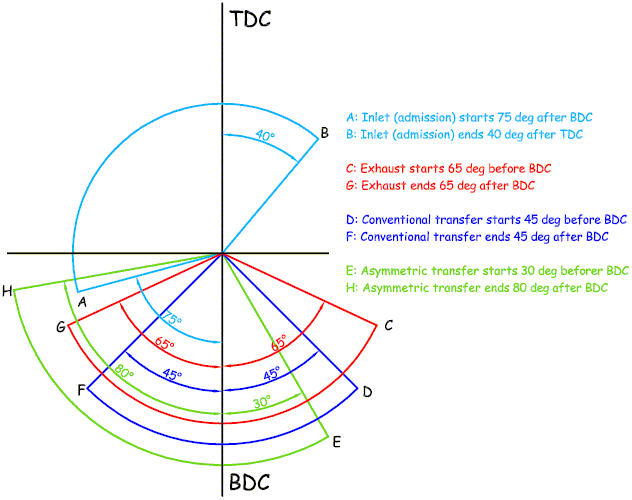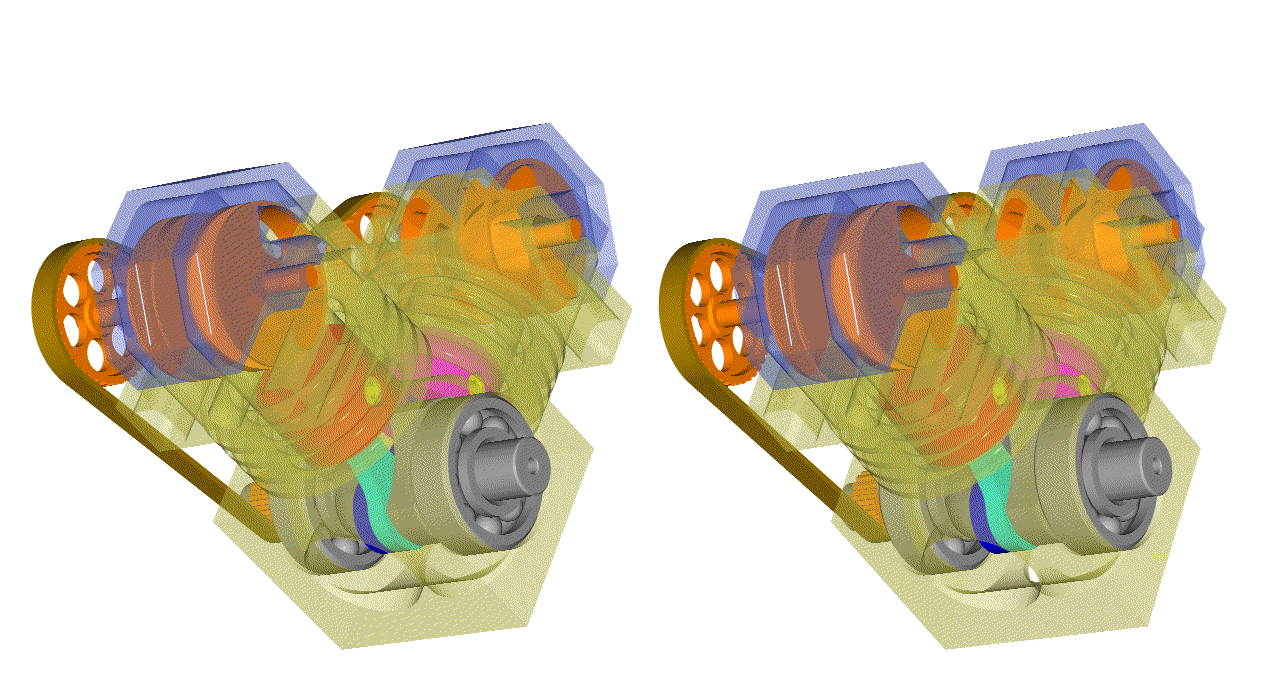Hello Munnix:
You write:
“Using gas pressure via gas ports is never "at the same time" and why this method is never used as the primary means, it is used as a secondary means as it takes some time for the pressure to build up, like charging a capacitor, it also takes time to discharge.
Case in point - piston rings, their tension performs the seal and gas pressure used to assist only.
This gas porting increases crevice volume and loss of cylinder pressure, creates additional heat that needs to be removed.
. . .
The F1 bishop engine had ultra thin 3mm needle roller bearing of only 10mm width, these worked fine in endurance testing. Even surviving when the 'normal' f1 rods broke when running at MBT ignition timing low 30s btdc due to the fast combustion, fatigue eventually caused the rod to fail, they learned timing needed to be retarded slightly from mbt.”
The typical 4-stroke and 2-stroke PatRoVa design is not adding crevice volume, at all.
The FlatHead 2-stroke PatRoVa does add some small crevice volume, which is a disadvantage, a side effect.
With small volume of the shallow groove above the 2Stroke FlatHead PatRoVa, the pressure need not time to built up (the pressure in the combustion chamber increases progressively, not explosively).
Despite the added crevice volume, I think that if Ralph Watson had thought this “solution” of his problem when he was trying, unsuccessfully, to make his first prototype Aspin engine to operate (read his article at
http://ralphwatson.scienceontheweb.net/rotary.html ) , he would be more than happy.
Let’s suppose the added crevice volume in the FlatHead 2-stroke PatRoVa is a big issue.
Doesn’t the 4-stroke Bishop rotary valve add crevice volume, too?
It does (the volume between the rotary valve, the cylinder head and the seals of the window at the top of the cylinder).
But this is nothing as compared to the parasitic “volumes” created around the Bishop rotary valve and cause more serious problems than the increased crevice volume.
The necessarily large clearance between the cylinder head and the valve is the main cause of the problem:
Put two “ultra thin 3mm needle roller bearing of only 10mm width” at some 130mm distance from each other, and support on them a thin-walled pipe (the Cross-Bishop rotary valve) having heavily asymmetrical structure with long / wide cuts (the ports) at its periphery, with an oblique separator at its middle and with highly asymmetric temperature distribution along and around the “pipe” (the one needle roller bearing works cold, the other has needles rolling on the red-hot “exhaust” side of the rotary valve, because the exhaust pipe is the inner ring of this needle roller bearing).
Then put a force of a couple of tons (20,000N) to press the middle part of the lower side of the pipe upwards, and you have the complete scene / picture.
The sealing means of the Bishop can follow the resulting distortion / bending of the pipe-like valve and can keep the high pressure gas into the cylinder.
However, the previously mentioned “characteristics” and “facts” call for “increased radial clearances”, and this is not good, at all.
Don’t believe me, believe the guys of the Bishop Team:
QUOTE from the US7,621,249 patent,
Assignee: Bishop Innovation Limited,
Inventors: Wallis and Thomas:
“The purpose of the present invention is to provide a mechanism that minimises the flow of gas from one port to another, and in particular during those portions of the cycle where there is a large pressure difference between the ports and where the resulting flows will create problems with the operation of the engine.
A typical example of where this is issue occurs is in high performance engines under full throttle. Because of the nature of these engines, they require larger radial clearances and are therefore more susceptible to adverse pressure drops between the ports. Under full throttle operation shortly after the exhaust port first opens the pressure in the exhaust port rises rapidly to well over 1 bar gauge. In arrangements like those in U.S. Pat. No. 4,852,532 (Bishop) this will result in the exhaust being pushed into the inlet port and a consequent loss of performance. Later in the cycle when the exhaust pressure drops below atmospheric, the transfer of exhaust gas to the inlet port is no longer a problem.
Another example occurs in engines operating under closed throttle conditions. During the induction stroke the cylinder and the inlet port are both pulled down to a very low pressure. If this occurs after the bridge between the inlet and exhaust port has passed over the trailing axial seal there is direct communication between the cylinder, the inlet port and the exhaust port through the gap that exists between the bridge and the bore in which the valve is housed. Exhaust will flow across the bridge into the inlet port driven by this high pressure drop between the ports.
The present invention is designed to work with a gas sealing system that consists of an array of floating seals positioned around the window and an oil sealing arrangement, both of which are disclosed in International Application PCT/AU2005/001306 published as WO 2006/024081 A1 (Bishop Innovation Limited) having the same priority date and applicant as the present invention. The present invention can however be adapted to work with other gas sealing arrangements having an array of floating seals such as the seal array disclosed in U.S. Pat. No. 5,509,386 (Wallis et al).”



END OF QUOTE
Besides the typical seals around the “window” at the ceiling of the combustion chamber (16a, 16b, 17 and 17), and the circular side seals (18 and 18), the Bishop rotary valve requires (according its inventors) another set of seals (like the 5 and 5A) to soften the problems caused by the necessarily large radial clearances and the architecture of the Cross-Bishop rotary valve that creates parasitic volumes around its periphery.
But, does the added seals really solve the problem?
Look at the Fig 5 and think what happens during the rotation (anti-clock-wise) of the Bishop rotary valve.
Due to the “required large radial clearances”, at the space between the periphery of the rotary valve and the cylinder head they are formed, inevitably, three independent parasitic spaces:
a first one between the 16b and 5a axial seals (and the circular seals 18/18),
a second one between the 5a and 5 axial seals (which extends some 180 degrees on the periphery of the rotary valve),
and a third one between the 5 and the 16a axial seals.
As the intake port 2 sweeps each one of these parasitic volumes, it fills them with air-fuel mixture.
At the next cycle, as the exhaust port 3 sweeps the same parasitic volume, the air-fuel mixture inside them is lost to the exhaust.
The second parasitic volume is so long (angularly), that for some 200 crank degrees (or so) the intake communicates with the exhaust though it. Any pressure difference between the intake and the exhaust causes either the loss of air-fuel mixture to the exhaust, or the contamination of the fresh charge in the rotary valve pipe with exhaust gas.
The above “weaknesses” / issues are not significant for a F1 or for a pure racing engine.
However these “issues”, together with the “total-loss lubrication of the rotary valve”, justify the fact that the Bishop rotary valve, despite the millions invested and lost on it, was never applied on normal engines.
To optimize the flow capacity of a rotary valve having such basic and significant problems / issues is meaningless.
To cure the basic design weaknesses is the first step to be done, and requires significant modifications of the design.
Only after the first (which, may require significant modifications of the design), only then you can deal with the optimization of the air flow.
The Bishop team worked hard (and, as you claim, they have spent millions of dollars) to solve the issues of the original Cross rotary valve.
Unfortunately they concentrated on the air flow capacity and on the fast combustion (the top requirements for a F1 engine) and forgot to deal with the fundamental issues / problems of the Cross rotary valve design.
It is now time to take another look at the PatRoVa and to think how many issues / problems it avoids with its simple / different architecture.
Thanks
Manolis Pattakos

